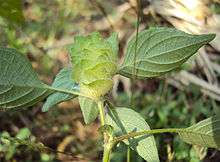Phaulopsis imbricata
| Phaulopsis imbricata | |
|---|---|
 | |
| Scientific classification | |
| Kingdom: | Plantae |
| (unranked): | Angiosperms |
| (unranked): | Eudicots |
| (unranked): | Asterids |
| Order: | Lamiales |
| Family: | Acanthaceae |
| Genus: | Phaulopsis |
| Species: | P. imbricata |
| Binomial name | |
| Phaulopsis imbricata (Forssk.) Sweet | |
| Synonyms | |
| |
Phaulopsis imbricata is a shrub native to South Africa.[1] It is also known as Himalayan ruellia. Leaves are opposite, one larger than the other in each pair, usually asymmetrical at the base.[2] Phaulopsis imbricata is a good fodder, the young leaves are eaten as a vegetable and the plant-ash in oil is rubbed into scarifications on the back for rheumatism in Tanganyika.[3] The flowers have an unpleasant smell.[4] It is filed as near-threatened by the IUCN.[5] It is one of the larval host plants of the butterflies great eggfly, tiny grass blue, brown pansy, soldier pansy and marbled elf.
References
External links
 Media related to Phaulopsis imbricata at Wikimedia Commons
Media related to Phaulopsis imbricata at Wikimedia Commons
| Wikispecies has information related to: Phaulopsis imbricata |
- Where seen
- Photos
- Dressler, S.; Schmidt, M. & Zizka, G. (2014). "Phaulopsis imbricata". African plants – a Photo Guide. Frankfurt/Main: Forschungsinstitut Senckenberg.
This article is issued from
Wikipedia.
The text is licensed under Creative Commons - Attribution - Sharealike.
Additional terms may apply for the media files.
